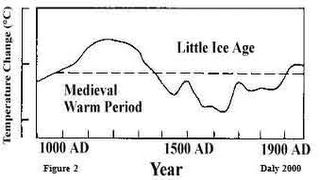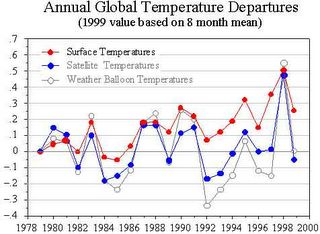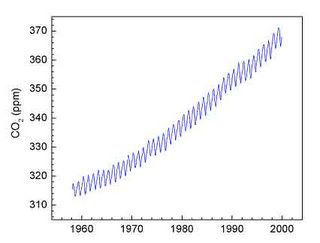Warming, Schmarming: Why the world is not coming to an end.
During a recent hike with a friend in the
I have looked into the issue of global warming before, but this weekend’s discussion renewed my interest in the subject. Here are some of the things which I have found:
Global Temperature (last 1,000 Years)
2) The study of the Earth’s climate is still relatively new and far from comprehensive. There are millions of variables involved, and scientists are only really beginning to understand the most basic factors such as solar radiation, ocean currents, and water vapor. Recent studies, particularly into solar factors, are suggesting that the Sun may be the most important factor in determining Earth’s climate.
3) Most of the graphs you see showing a hockey-stick-style, exponential increase in temperature over the last few decades are based on bad data. The problem is that they use surface temperature readings. Now let’s say that temperatures have been recorded in
Surface vs. Satellite and Weather Ballon Data
(N.B. how poorly the Satellite and Weather Ballon temperature readings correlate the CO2 increases in the graph above. Also, the spike in all three at the very end is due to the El Nino in 1998.)
4) Atmospheric carbon Dioxide does not correlate to temperature in the way is should if the alarmist models are to be believed. We see this above with the satellite data since the 1970s. It is also evident is the last 100 years. Much of the recorded global warming during that period took place between 1900 and 1940 (surface readings showed about 0.5°C), before much of the sharp increase in man’s CO2 output. As the CO2 output rose from 1940 to 1975, surface reading temperatures dropped 0.2°C. Nor does this appear to be just the case before the 20th century. Some scientist have found from Antarctic ice core data that CO2 follows the same basic pattern as global temperature in the last 500,000 years. However, when they looked more closely, they found that CO2 lagged behind temperature, suggesting that CO2 levels were more of an effect rather than a cause of climate change.
5) Carbon Dioxide is not the main greenhouse gas; water vapor is. Water vapor accounts for 97% of greenhouse gases. Although atmospheric CO2 has increased from 280 ppm to 370 ppm over the last 100 years, it accounts for 0.035 % of the atmosphere. Some scientist believe that an increase of 500 % would not have a major or detrimental effect, compared to the 30 % increase we have already witnessed. If those estimates are correct, perhaps the question might be if we have enough fossil fuels to reach the threshold needed for large-scale climatic change!
6) The computer models you have seen are woefully inadequate. I assume you have all seen the alarming computer generated graphics of the Earth’s surface turning from blue to red. These are usually portrayed on TV in such a manner so as to arouse fear in the viewer thanks to clever use of music and disquieting commentary. They are often displayed to cause an emotional reaction. Unfortunately, these models would be more properly viewed as preliminary sketches for ‘The Incredibles’ than they represent accurate predictions. It is like trying to predict who wins the World Series based on a close examination of the Dodgers. In fact, as a whole they fare no better in past climate predictions than a random set of numbers. Richard Feynmann called our fascination with computer models a disease.
7) Man has little to do with glaciers disappearing. I know, you have seen pictures from 1900 showing glaciers and pictures from this year showing little or no glaciers attached to an article saying that evil Americans are driving away the glaciers and that Polynesians will soon be drowning. Again, these pictures and the stories that accompany them and meant to elicit an emotional reaction. Yes, the glaciers are shrinking. No, this is not time to panic. Glaciers once covered much of
Sheets of ice in
8) Global warming due to mankind is not causing extreme weather. A good example of this was last year’s hurricane season in
9)
10) CO2 is good. It is essential to life on earth. Just as athletes compete better at sea level where their lungs can take in more oxygen, so plants grow better with increased carbon dioxide in the atmosphere. Recent studies show just that occurring.
I could go on, but should stop there for now. The root problem with climate change, as for environmentalism as a whole, is that it is religious in nature. As MIT Meteorologist Richard Lindsen put it: "Do you believe in global warming? That is a religious question. So is the second part: Are you a skeptic or a believer?"
Environmentalism has actually become a caricature of Christianity. It has a Mother Earth, the original sin of industrialization, a humanity which delights in it freedom to sin with a elect few who have heard the gospel of recycling and renewable energy. Most importantly, however, it has its own Eschatology. When the Black Death swept western Europe, one reaction was that of the Flagellants (please, that’s Flagellants) who scourged themselves in public penance in the hopes that propitiating an angry god would assuage the epidemic. Most may now laugh at such behavior or attitudes, but the basic sentiment is still alive today. In order to repent of the sins of industrialization, they call for the economic scourging of the industrialized world. And just like Christian believers, they never live up to their beliefs. They still drive cars, import IPods, suck Lattes and take hot showers. Unfortunately the only thing differentiating environmentalism from Christianity is the lack of a redeemer. This leads me to question whether modern environmentalism’s view of original sin is merely a by-product of the Christian culture of the West in which it developed, as if merely by chance, or does its it come from a more primordial source- a root understanding of the sinfulness of man and his discord with the rest of creation.
At any rate, climatic apocalypticism provides an interesting study in science and society. Scientific studies are filtered through bureaucracies and a press that slants and distorts information to fit their own preconceptions on global warming. Advocates distort information and researchers rarely criticize the more extreme spin as alarm over a potential crisis brings more research money. Alarmists misrepresent scientific opinion in an attempt to manufacture consensus on global climate change as publications with unsympathetic editors refuse dissenting articles on the basis it might prevent political action (see here). Some global warming skeptics have even lost their jobs (see Wildlife groups axe Bellamy as global warming ‘heretic’). One wonders if the global warming alarmists’ ever increasing dogmatism is a response to the growing evidence against their position.
Ultimately I encourage you to research the scientific data for yourselves and to draw your own conclusions. Just be aware that what you have been fed by the press is not necessarily the case, and that they often play upon your emotions. There are numerous scientist at distinguished institutions who dissent from the popular view of global warming, and a large amount of uncertainty in any comprehensive study of world climate. Use energy wisely and ignore the environmental extremists and their doomsday scenarios. In the end, necessity is the mother of all invention: once global demand for fossil fuels outstrips supply, rising energy prices will provide the financial conditions necessary for man to develop the next realistic large-scale source of energy. Until then, the world won’t come to a climatic end.
http://ff.org/centers/csspp/misc/index.html





0 Comments:
Post a Comment
<< Home